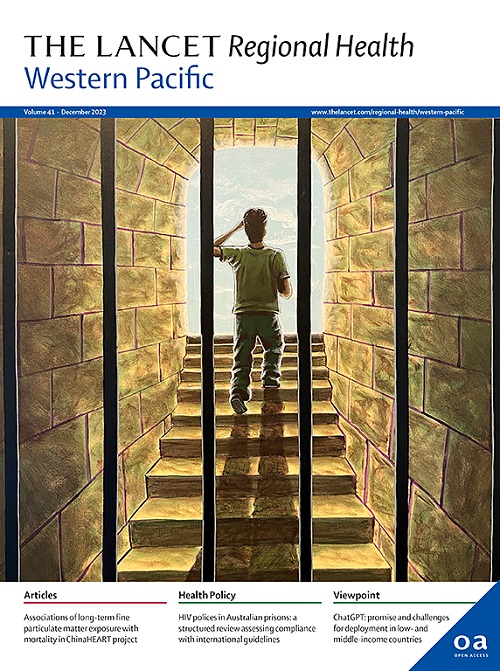Prevalence of blood-borne virus infections and uptake of hepatitis C testing and treatment in Australian prisons: the AusHep study
IF 7.6
1区 医学
Q1 HEALTH CARE SCIENCES & SERVICES
引用次数: 0
Abstract
Background
Incarcerated people are at high risk of blood-borne virus infections, particularly HCV, and a priority population for elimination efforts. This national bio-behavioural survey evaluated blood-borne virus prevalence and HCV testing-and-treatment uptake amongst people in Australian prisons.
Methods
Randomly-selected participants from 23 representative prisons nationally were offered point-of-care testing for HIV and HCV (anti-HCV) antibodies, hepatitis B surface antigen (HBsAg), and HCV RNA (if anti-HCV positive). Demographic data and previous HCV testing and treatment were collected by structured interview.
Findings
1599 individuals participated (98% participation; 89%male; median age 35 years; 49% ever injected drugs). Prevalence estimates were: 31.7% (95% CI:28.8–34.8) for anti-HCV; 8.0%for HCV RNA (95% CI:6.4–9.9); 0.5% (95% CI:0.2–1.1) for HBsAg, and 0.8% (95% CI: 0.4–1.7) for HIV antibody. Among participants who had ever injected drugs (n = 787), HCV RNA prevalence was highest among those injecting and sharing needles/syringes within the past month [27.9%; adjusted odds ratio (aOR):4.54 (95% CI:2.65–7.77). Among participants (n = 1599), 70.4% (95% CI: 67.4–73.2) had ever been tested for HCV (62.6% in prison). The highest likelihood of having had HCV testing was observed among participants who injected drugs in the past month (aOR = 10.37, 95% CI:5.72–0.18.78). Among those eligible (n = 318), 84.6% (95% CI:79.2–88.7) had ever received HCV treatment (75.0% in prison), and 67.8% (95% CI:61.7–73.4) were cured. The likelihood of HCV treatment was higher among those previously imprisoned, (aOR = 2.67, 95% CI:1.20–5.93).
Interpretation
Despite high overall HCV testing and treatment uptake, the lower uptake and substantial ongoing HCV disease burden in some sub-populations highlights the need for continued prison-based elimination efforts with population-specific interventions.
Funding
The AusHep study was funded by the Australian Government Department of Health and Aged Care.
澳大利亚监狱中血液传播病毒感染流行率和丙型肝炎检测与治疗接受率:AusHep 研究
背景被监禁者是血液传播病毒感染(尤其是丙型肝炎病毒)的高风险人群,也是消除病毒工作的重点人群。这项全国性的生物行为调查评估了澳大利亚监狱中血液传播病毒的流行情况以及HCV检测和治疗的接受情况。方法从全国23所具有代表性的监狱中随机抽取参与者,为他们提供HIV和HCV(抗-HCV)抗体、乙型肝炎表面抗原(HBsAg)以及HCV RNA(如果抗-HCV阳性)的床旁检测。通过结构化访谈收集了人口统计学数据以及之前的 HCV 检测和治疗情况。研究结果 1599 人参与(98% 参与;89% 男性;年龄中位数为 35 岁;49% 曾经注射毒品)。患病率估计值为抗-HCV 感染率为 31.7%(95% CI:28.8-34.8);HCV RNA 感染率为 8.0%(95% CI:6.4-9.9);HBsAg 感染率为 0.5%(95% CI:0.2-1.1);HIV 抗体感染率为 0.8%(95% CI:0.4-1.7)。在曾经注射过毒品的参与者(n = 787)中,过去一个月内注射并共用针头/注射器者的 HCV RNA 感染率最高[27.9%;调整后的几率比(aOR):4.54 (95% CI:2.65-7.77)。在参与者(n = 1599)中,70.4%(95% CI:67.4-73.2)曾接受过 HCV 检测(监狱中为 62.6%)。在过去一个月内注射过毒品的参与者中,接受过丙型肝炎病毒检测的可能性最高(aOR = 10.37,95% CI:5.72-0.18.78)。在符合条件的参与者(n = 318)中,84.6%(95% CI:79.2-88.7)曾接受过 HCV 治疗(75.0% 在监狱中),67.8%(95% CI:61.7-73.4)已治愈。尽管HCV检测和治疗的总体接受率较高,但某些亚人群的接受率较低,且HCV疾病负担较重,这突出表明有必要继续在监狱开展消除HCV的工作,并针对特定人群采取干预措施。
本文章由计算机程序翻译,如有差异,请以英文原文为准。
求助全文
约1分钟内获得全文
求助全文
来源期刊

The Lancet Regional Health: Western Pacific
Medicine-Pediatrics, Perinatology and Child Health
CiteScore
8.80
自引率
2.80%
发文量
305
审稿时长
11 weeks
期刊介绍:
The Lancet Regional Health – Western Pacific, a gold open access journal, is an integral part of The Lancet's global initiative advocating for healthcare quality and access worldwide. It aims to advance clinical practice and health policy in the Western Pacific region, contributing to enhanced health outcomes. The journal publishes high-quality original research shedding light on clinical practice and health policy in the region. It also includes reviews, commentaries, and opinion pieces covering diverse regional health topics, such as infectious diseases, non-communicable diseases, child and adolescent health, maternal and reproductive health, aging health, mental health, the health workforce and systems, and health policy.
 求助内容:
求助内容: 应助结果提醒方式:
应助结果提醒方式:


